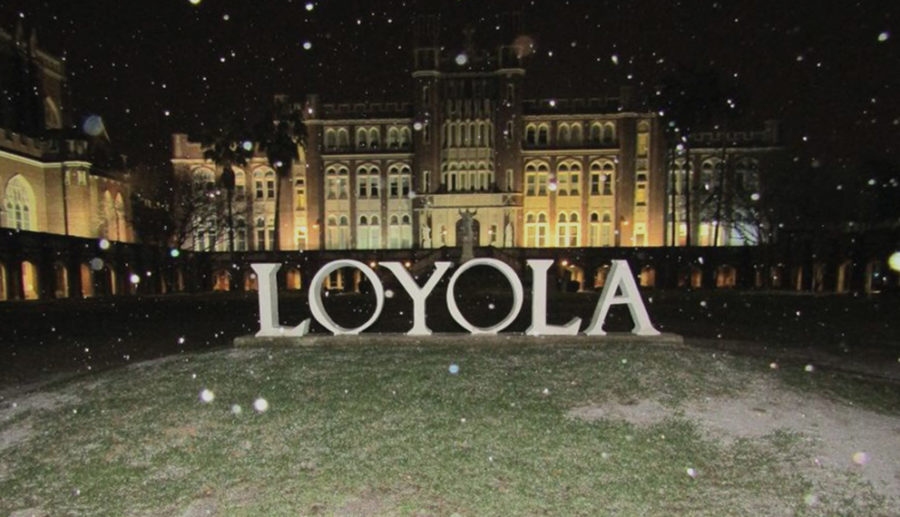Editorial: Loyola goes on ice break
Sleet, not sneaux, falls in front of the Loyola letters at the Horseshoe Jan. 16, 2018. Loyola was the last four-year university in New Orleans to cancel classes for that day. ANDERSON LEAL/The Maroon. Photo credit: Anderson Leal
January 26, 2018
Last week, there was no print edition of The Maroon.
You might have noticed.
Even if you only wanted to pick up a copy to cover your head from freezing rain, our newsstands were noticeably empty — along with the rest of campus. And if you live in the dorms and decided to walk around last Wednesday or Thursday, you’d know why.
Loyola was a proper ice rink.
That’s why there’s no doubting the decision to cancel classes on Wednesday and Thursday was the right move, but there’s also no doubting it was a late move, as everything from City Hall to elementary schools sent out word they were closing before Loyola did.
Most with a rational grasp on New Orleans’ ability to handle winter weather events saw this coming, but for some reason, Loyola seemed bent on toughing it out.
An email sent out on Jan. 16 by Interim Provost David Borofsky said that normal operations planned to remain for Jan. 17, even though it acknowledged that other schools across the city were shutting down.
It was only late in the afternoon of Jan. 16, after the Commuter Student Association rightly sent out their own email telling students to only come to class if roadways were safe, that Loyola decided to change its mind, canceling classes for the 17th. It was a similar story with the waiting game the next day.
Loyola’s tardiness wasn’t without consequences, as everyone tried to plan for the next day, under “normal operations,” even though the rest of the city was closed. You might’ve even noticed some Maroon staffers skidding through campus as we still had the idea school would open soon enough for us to put together a newspaper. Yeah — no. We weren’t about to have someone break their leg trying to get to our office.
So our question is: What was Loyola thinking in the first place?
When Borofsky sent out that email reiterating that we were staying open even though the entire city closed, what were decision makers possibly thinking?
This isn’t the Midwest. We don’t have a supply of snowplows and trucks to salt the road waiting on standby for situations like this. We don’t have the option to keep roadways open for any event less than a blizzard.
And it wasn’t even snow we dealt with — it was freezing rain and ice, which anyone with experience living with winter weather will tell you is the most dangerous to drive in.
So on a campus where 56 percent of students don’t live on it, and in a city filled with bridges, deciding not to put they nor their instructors lives at risk by driving on frozen roads wouldn’t seem like a hard, last-second decision. It’s an easy one.
But for anyone who listened to their professors go over their syllabuses in the first week of classes, guess it shouldn’t come as a surprise.
First day of class — professor: “Now let’s take a look at the emergency prep part of the syllabus … well, hurricane season’s over. K. Thnx. Bye.”
It may have gotten colder than usual last week, but this nonchalant approach to winter weather threats is unfounded.
We get winter weather events in New Orleans. It happens. In 2014, sleet, snow and/or freezing rain events happened in south Louisiana four times — with two of those coming in the span of a week, while Louisiana’s only been hit by a hurricane twice in the last nine years.
Bottom line, Loyola needs to be aware of winter weather events and be proactive when those situations come.
We shouldn’t need someone dying — like what happened to a baby in Metairie — to remind us of how dangerous those situations are.
So, again, good move by canceling classes. Let’s just figure out the obvious a little earlier next time.








